Conditions
Conditions are used in Condition blocks and some List blocks such as the blocks Compare Lists
and Filter Lists
. Conditions are also used in the if
formulas.
The available conditions are described below.
Conditions for Values (text, number)
Equal
The Condition answer is Yes
(true) when argument1 and argument2 are equal, meaning the text or number is identical.
Example:
The Condition dropdown.
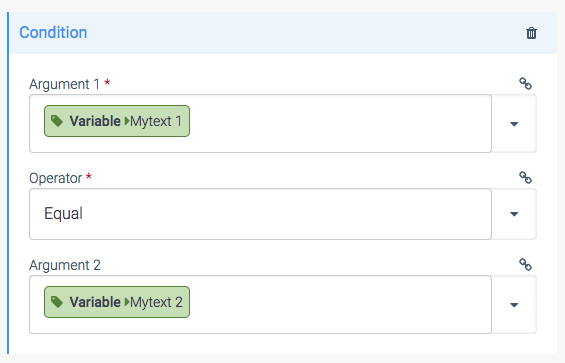
Not equal
The Condition answer is Yes
(true) when argument1 and argument2 are not equal, meaning the text or number is not identical.
Conditions for Numbers
Greater than
The Condition answer is Yes
(true) when argument1 is a number that is greater than (higher than/bigger than) the number of argument2.
Example:
The Condition dropdown.
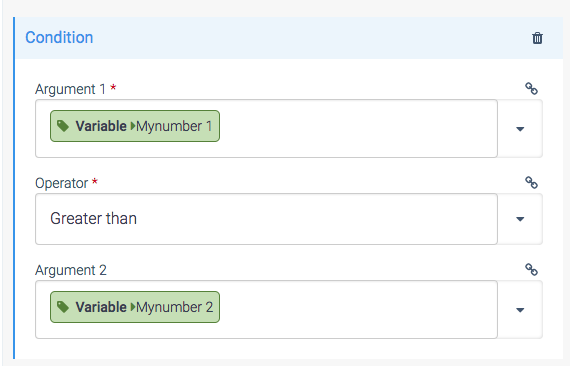
Greater than or equal
The Condition answer is Yes
(true) when argument1 is a number that is greater than (higher than/bigger than) the number of argument2 and the answer is also Yes
(true) when both numbers are equal.
Less than
The Condition answer is Yes
(true) when argument1 is a number that is lower than (smaller than/less then) the number of argument2.
Less than or equal
The Condition answer is Yes
(true) when argument1 is a number that is lower than (smaller than/less than) the number of argument2 and the answer is also Yes
(true) when both numbers are equal.
Conditions for Type validation
Is empty
The Condition answer is Yes
(true) when argument1 has an empty value, e.g. an empty text, a null
value, a list that does not contain any items or an object that does not have any key/values.
Example:
The Condition dropdown.

Is not empty
The Condition answer is Yes
(true) when argument1 does not have an empty value, e.g. it's a text that is not empty, it's a list that has one or more items, or it's an object that has one or more key/values.
Is text
The Condition answer is Yes
(true) when argument1 has a value which is a text, meaning it's not an object or a list.
Is not text
The Condition answer is Yes
(true) when argument1 has a value which is not a text, meaning it's e.g. an object or a list.
Is number
The Condition answer is Yes
(true) when argument1 has a value which is a number (e.g. 5 or 7.48), meaning it's not a text such as John Doe
, it's not a list and it's not an object.
Is not number
The Condition answer is Yes
(true) when argument1 has a value which is not a number.
Is object
The Condition answer is Yes
(true) when argument1 has a value which is an object with key/values, meaning it's not a single value such as a text or number and it's not a list.
Example JSON representation of an object:
{
"key1": "value1",
"key2": 56.78,
"key3": [ "value2", "value3" ],
"key4": [ {"key5": "value5"} ]
}
Is not object
The Condition answer is Yes
(true) when argument1 has a value which is not an object with key/values, meaning it's e.g. a single value such as a text or number or it's a list.
Is list
The Condition answer is Yes
(true) when argument1 has a value which is a list with zero or more items, meaning it's an empty list or a list with one or more items. Note that the Loop block can only be applied on Lists (not objects or other values). The items of the list can be any value (text, numbers, objects, other lists etc.).
Example JSON representation of a list:
[
{ "key1": "value1" },
{ "key1": "value2" }
]
Is not list
The Condition answer is Yes
(true) when argument1 has a value which is not a list, meaning its value is null
or it's a text or number or it's an object.
Is email
The Condition answer is Yes
(true) when argument1 has a value which is a valid email address. Use this condition to validate email addresses.
Note that the format of the email address is checked, but the Condition will not check if this is an existing mailbox that can receive email. No SMTP check will be performed.
Example:
The Condition dropdown.
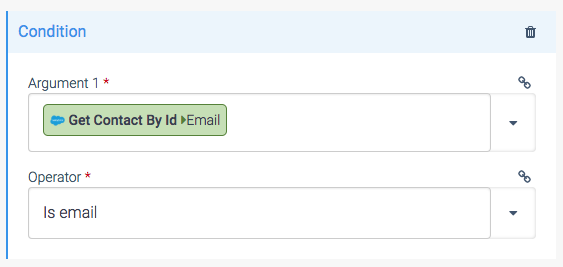
Is not email
The Condition answer is Yes
(true) when argument1 has a value which is not a valid email address.
Is phone
The Condition answer is Yes
(true) when argument1 has a value which is a valid phone number. Use this condition to validate phone numbers.
Note that the format of the phone number is checked, but the Condition will not check if this is an existing phone number.
Is not phone
The Condition answer is Yes
(true) when argument1 has a value which is not a valid phone number.
Conditions for Text
Contains
The Condition answer is Yes
(true) when argument1 is a text that contains the text from argument2.
Example:
The Condition dropdown.
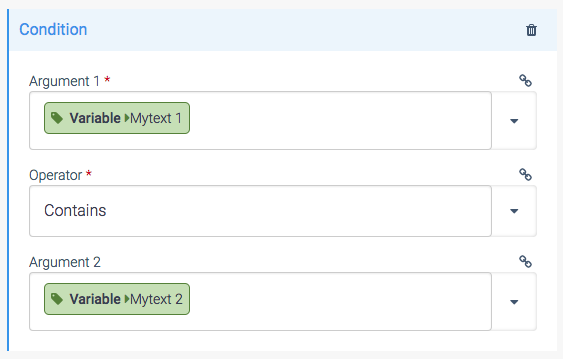
In the above example, the Condition answer will be Yes
(true) when Mytext1 is e.g. John Doe
and Mytext2 is Doe
.
In other words, argument2 (needle) will be searched in argument1 (haystack) and both need to be a text.
This Condition can also be used to look for a value in a comma-separated text. For example, if Mytext1 is apple, banana, orange
, and Mytext2 is banana
, the answer of the Condition will be Yes
(true).
Does not contain
The Condition answer is Yes
(true) when argument1 is a text that does not contain the text from argument2.
Conditions for Lists
List contains
The Condition answer is Yes
(true) when argument1 is a list that contains one item that is identical to argument2.
Example:
The Condition dropdown.
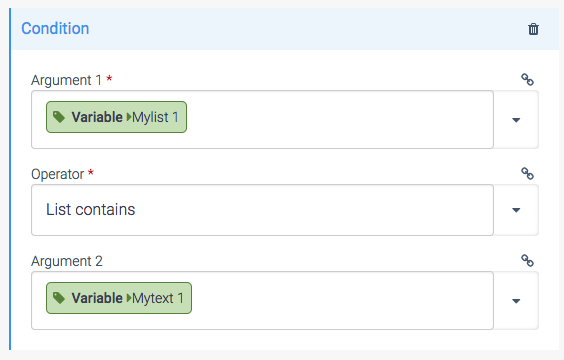
In the above example, Mylist1 (argument1) is e.g. a list of text values and Mytext1 (argument2) is a text value (NOT a list !).
Example JSON representation of Mylist1:
[
"apple",
"banana"
]
Example JSON representation of Mytext1:
"banana"
For the above example, the Condition answer will be Yes
(true).
List does not contain
The Condition answer is Yes
(true) when argument1 is a list that does not contain an item that is identical to argument2.
Conditions for Boolean values
Is true
The Condition answer is Yes
(true) when argument1 has a boolean value equal to true.
Is false
The Condition answer is Yes
(true) when argument1 has a boolean value equal to false.
Did this page help you?
If you find any issues with this page or its content – a typo, a missing step, or a technical error – let us know how we can improve!
